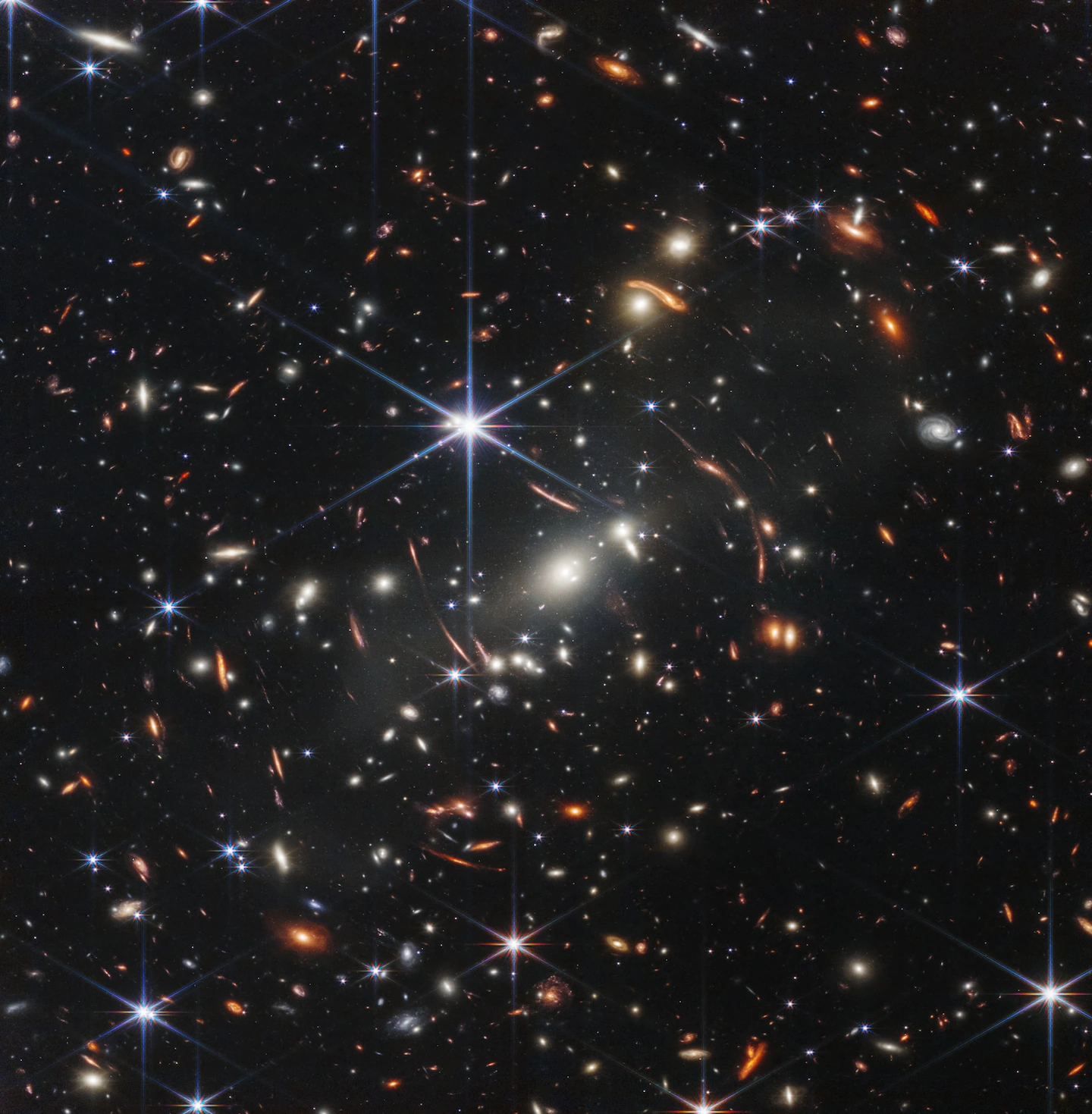“We’re looking back more than 13 billion years,” NASA Administrator Bill Nelson said at the White House event. “Light travels at 186,000 miles per second, and that light that you are seeing from one of those little specks, has been traveling for over 13 billion years.”
He added: “And by the way, we’re going back further. Because this is just the first image. … We’re going back almost to the beginning.”
The new image is what is known as a “deep field” observation, with the telescope staring at what NASA called a “patch of sky approximately the size of a grain of sand held at arm’s length by someone on the ground.”
Outer space when viewed like this looks incredibly crowded — not so very spacious at all. What the Webb sees through this pinhole examination of the cosmic darkness is a hornet’s nest of brilliant but enigmatic objects in many colors. A smattering of stars have parked themselves in the foreground, but everything else is a galaxy — a vast agglomeration of stars, rendered into a small splash of light by the immense distances involved.
Strikingly, the lensing effect has distorted some of the distant galaxies in the background, making them appear stretched and manipulated, as if made of Play-Doh.
“It’s astounding,” Biden said, expressing awe at the sight of “the oldest documented light in the history of the universe — from over 13 billion — let me say it again — over 13 billion years ago.”
The White House described the image as the “highest-resolution images of the infrared universe ever captured.” The Webb is designed to observe in the infrared portion of the electromagnetic spectrum, gathering light at wavelengths inaccessible to the acclaimed Hubble telescope.
The White House event was a preview of a more comprehensive reveal of images during a news conference scheduled for Tuesday morning at NASA’s Goddard Space Flight Center in Greenbelt, Md.
NASA and its partners, the European Space Agency and the Canadian Space Agency, have been keeping a close hold on the first Webb images during the initial sequence of observations as the telescope, launched last Christmas, orbits the sun roughly a million miles from Earth. NASA has previously released a few testing-phase images of the telescope — thrilling astronomers with their clarity — but has described the images being released Monday and Tuesday as the first full-color images.
The astronomical community is buzzing with excitement, awaiting what it believes will be revolutionary views of the universe across cosmic distances and with unrivaled resolution. The Webb promises to study planets that orbit distant stars, looking for signs of possible habitability — such as the presence of an atmosphere similar to Earth’s.
“You’re going to see whether or not planets, because of the chemical composition that we can determine with this telescope, of their atmosphere, if those planets are habitable,” Nelson said.
The telescope — conceived as the successor to the still-operational Hubble — “has capabilities that far surpass my most optimistic dreams,” Garth Illingworth, an astronomer at the University of California at Santa Cruz who in the late 1980s was instrumental in developing plans for an infrared space telescope, wrote in an email to fellow astronomers Monday. “The capabilities of Webb are truly out of this world.”
The initial deep look into the universe by the Webb is just a taste of what is to come, said planetary astronomer Heidi Hammel, who is among the scientists scheduled to use the Webb in coming months. Hammel described the initial deep look unveiled Monday as “proof of concept … whetting our appetite for the record-breaking results we now know will come from this exceptional facility.”
Regardless of whatever wow factor is generated by the new images, the significant fact is that the Webb works. This was never a slam-dunk mission. The telescope was repeatedly delayed, and its price tag soared. At one point, Congress nearly killed the project. For many years, it was unclear whether the Webb would get off the ground, literally.
The ambitious scientific goals set out by NASA and its partners required a revolutionary design. The scientists who in the 1980s began advocating for what was originally called the Next Generation Space Telescope argued that an infrared space observatory would be able to peer deeper into the universe — and further back in time, to an era roughly a few hundred million years after the big bang. That’s when the first stars ignited and starlight flooded the young universe.
The telescope — or the “observatory,” as scientists often call it — features 18 gold-plated, hexagonal, individually maneuverable mirrors that function like a single mirror about 21 feet across. This giant light bucket is not inside a protective tube but rather is open to the universe like a flower.
The mirrors, cameras and other instruments that need to be kept ultracold for infrared astronomy are protected from the sun’s radiation by a five-layered, tennis-court-sized sun shield. The sun shield and many other components, including the mirrors, were folded up at launch and had to be deployed during the telescope’s nearly month-long journey to its orbital post.

A cold, clear eye on the heavens
The James Webb Space Telescope observes in the infrared portion of the spectrum, which requires the mirrors, cameras and other instruments to remain at extremely cold temperatures — not far above absolute zero. As a result, the telescope requires
a massive sun shield to protect against
solar radiation.
Science
instrument
module containing cameras used in these images
18-segment
primary mirror
Spacecraft control
machinery
Sources: NASA; Space Telescope Science Institute
WILLIAM NEFF/THE WASHINGTON POST

A cold, clear eye on the heavens
The James Webb Space Telescope observes in the infrared portion of the spectrum, which requires the mirrors, cameras and other instruments to remain at extremely cold temperatures — not far above absolute zero. As a result, the telescope requires a massive sun shield to protect against solar radiation.
Science
instrument
module containing cameras used in these images
18-segment
primary mirror
Spacecraft control
machinery
Sources: NASA; Space Telescope Science Institute
WILLIAM NEFF/THE WASHINGTON POST

A cold, clear eye on the heavens
The James Webb Space Telescope observes in the infrared portion of the spectrum, which requires the mirrors, cameras and other instruments to remain at extremely cold temperatures — not far above absolute zero. As a result, the telescope requires a massive sun shield to protect against solar radiation.
Science
instrument
module containing cameras used in these images
18-segment
primary mirror
Spacecraft control
machinery
Sources: NASA; Space Telescope Science Institute
WILLIAM NEFF/THE WASHINGTON POST

Seeing the universe
through a broader spectrum
Peering into space with just our eyes shows us the optical portion of the electromagnetic spectrum – a fraction of the energy in the universe, often obscured by interstellar dust and gases. The James Webb telescope’s ability to see far into the infrared spectrum will afford scientists a clearer view into the deep cosmos than has been possible before.
Spitzer
Space
Telescope
(retired)
James
Webb
Space
Telescope
Sources: NASA; European Space Agency;
Space Telescope Science Institute
WILLIAM NEFF/THE WASHINGTON POST

Seeing the universe
through a broader spectrum
Seeing the universe
through a broader spectrum
Peering into space with just our eyes shows us the optical portion of the electromagnetic spectrum – a fraction of the energy in the universe, often obscured by interstellar dust and gases. The James Webb telescope’s ability to see far into the infrared spectrum will afford scientists a clearer view into the deep cosmos than has been possible before.
Spitzer Space
Telescope
(retired)
James Webb
Space Telescope
Sources: NASA; European Space Agency;
Space Telescope Science Institute
WILLIAM NEFF/THE WASHINGTON POST

Seeing the universe through a broader spectrum
Peering into space with just our eyes shows us the optical portion of the electromagnetic spectrum – a fraction of the energy in the universe, often obscured by interstellar dust and gases. The James Webb telescope’s ability to see far into the infrared spectrum will afford scientists a clearer view into the deep cosmos than has been possible before.
James Webb Space Telescope
Spitzer Space Telescope (retired)
Sources: NASA; European Space Agency; Space Telescope Science Institute
WILLIAM NEFF/THE WASHINGTON POST
One report found 344 separate things that could go wrong — “single point failures” — and potentially derail the entire project. The telescope is not designed to be fixed if something goes seriously awry. The instruments are not modular and cannot be swapped out if they break. Unlike the Hubble, the Webb is too far away to be visited by astronauts.
But none of those single point failures happened. The Webb has surpassed astronomer’s scientific expectations, despite getting dinged recently by a micrometeoroid that put one of the mirror segments slightly out of whack.
“This telescope is one of humanity’s great engineering achievements,” Vice President Harris said Monday at the unveiling.
The Webb will study the formation of the earliest galaxies and the evolution of the universe as it has expanded. And it will look at objects that are in our own solar system, including small, icy worlds beyond the orbit of Neptune.
NASA on Friday identified the five initial “targets” of the Webb:
- Wasp-96 b: This is a giant planet, maybe half the size of Jupiter, that circles a star 1,150 light-years from Earth. The planet is too close to the brilliant star to be resolved as an individual object, but an instrument on the telescope has obtained the spectra of the planet, a scientifically important feat because it can reveal the composition of the planet’s atmosphere.
- Southern Ring Nebula: Located about 2,000 light-years away, the nebula is a gas cloud surrounding a dying star.
- Carina Nebula: The nebula is packed with stars, including the ultraluminous star system Eta Carinae. Situated roughly 7,500 light-years from Earth, within our own Milky Way galaxy, the nebula is visible from the Southern Hemisphere.
- Stephan’s Quintet: Five beguiling galaxies, four of them in a cluster about 290 million light-years away, in the constellation Pegasus. The quintet has been previously observed by the Hubble, and the new image will allow a side-by-side comparison of what the two space telescopes see as they gather light in different wavelengths.
- SMACS 0723: The deepest look. The galaxies in the cluster operate as a gravitational lens and, according to NASA, “magnify and distort the light of objects behind them, permitting a deep field view into both the extremely distant and intrinsically faint galaxy populations.”



